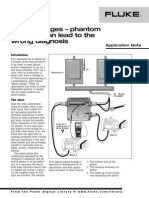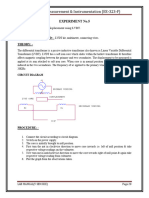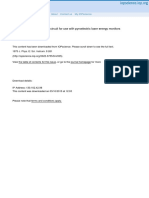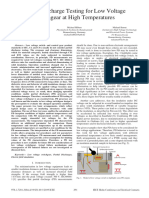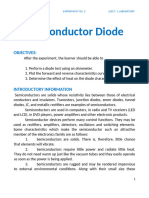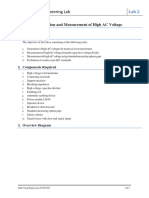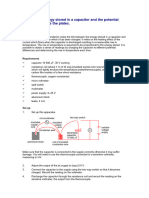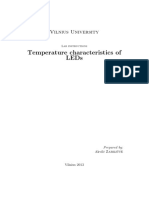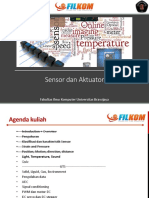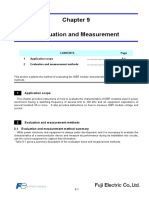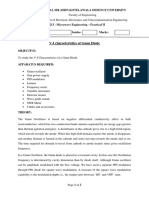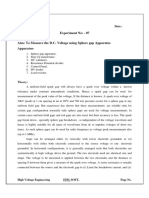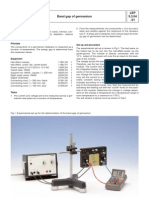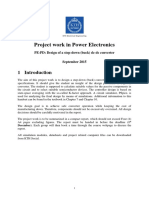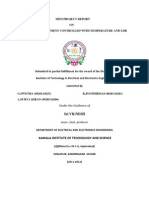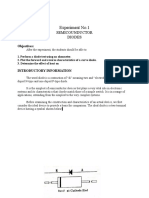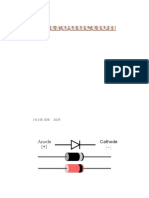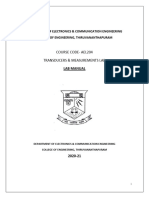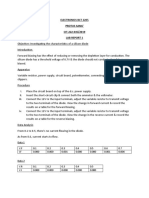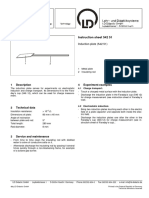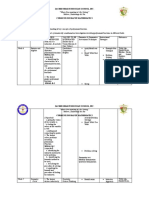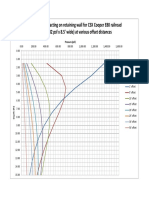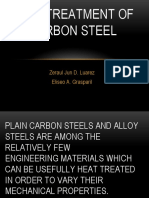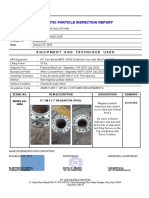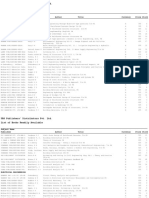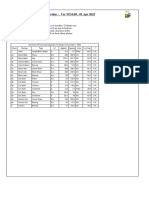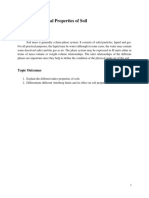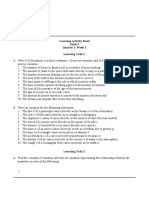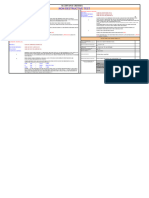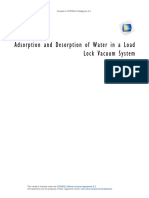Solid State Physics: Determining The Transition Tem-Perature of A High-Temperature Superconductor
Solid State Physics: Determining The Transition Tem-Perature of A High-Temperature Superconductor
Uploaded by
Barthélemy HoubenCopyright:
Available Formats
Solid State Physics: Determining The Transition Tem-Perature of A High-Temperature Superconductor
Solid State Physics: Determining The Transition Tem-Perature of A High-Temperature Superconductor
Uploaded by
Barthélemy HoubenOriginal Title
Copyright
Available Formats
Share this document
Did you find this document useful?
Is this content inappropriate?
Copyright:
Available Formats
Solid State Physics: Determining The Transition Tem-Perature of A High-Temperature Superconductor
Solid State Physics: Determining The Transition Tem-Perature of A High-Temperature Superconductor
Uploaded by
Barthélemy HoubenCopyright:
Available Formats
LD
Solid State physics
Physics
Conduction Phenomena
Leaflets P7.2.6.1
Superconductivity
Determining the transition tem-
perature of a high-temperature
superconductor
Objects of the experiment
g Record the voltage drop across a superconductor with varying temperature.
1 Principles
Superconductivity was discovered in 1911, when Kamerlingh
Onnes found that the electric resistance of mercury dropped
to zero at cryogenic temperatures. The so called transition
temperature when a conductor becomes superconducting
depends on the material used. For the next 75 years, the
transition temperatures were just in the 10 to 20 K range.
In 1986 the discovery of the high-temperature superconduc-
tors with transition temperatures in excess of 90 Kelvin, and
above the boiling point of liquid nitrogen (77 K), raised the
interest in those substances.
The superconductor used consists of Yttrium-Barium-Copper-
Oxide(Y Ba2 Cu3 O7).
The Experiment kit 667 552 is used to investigate the proper-
ties of a high-temperature superconductor in liquid nitrogen.
At a temperature of approximately 93 K or –180 °C, it shows
a sharp decrease in the voltage drop across the supercon-
ductor.
Safety notes
Just as a Thermos flask can burst if hot water is poured into it,
a Dewar flask could implode when it is filled with liquid nitrogen.
For this reason, always wear safety goggles when handling
Dewar flasks. Nitrogen, the largest constituent of the air we
breathe, is completely non-toxic. In spite of this, the evaporation
of large quantities in closed spaces could pose hazards, e.g. if
a full 25 l flask explodes. Such dangers can be easily avoided
by ensuring adequate ventilation and using small Dewar flasks
when performing the experiments. Proceed with caution, in
view of the low temperatures involved. Never reach into liquid
Wie 0607
nitrogen or touch cooled objects with bare hands (wear protec-
tive gloves). Avoid skin contact.
Local regulations on hazardous materials apply otherwise.
LD Didactic GmbH . Leyboldstrasse 1 . D-50354 Huerth / Germany . Phone: (02233) 604-0 . Fax: (02233) 604-222 . e-mail: info@ld-didactic.de
©by LD Didactic GmbH Printed in the Federal Republic of Germany
Technical alterations reserved
P7.2.6.1 -2- LD Physics leaflets
2 Integrated measuring module 3 Adapter for data acquisition
The measuring head to be dipped into liquid nitrogen contains Fig. 3 provides a schematic view of the adapter for data ac-
the Superconductor and a Platinum thermal resistor on board. quisition, which serves as a measuring device as well as a
The wiring of the superconductor and the Platinum resistor is voltage supply.
shown in fig. 2. A highly stable current of approx. 140 mA is
applied between points 1 and 4. The voltage drop is
measured across contact points 2 and 3.
Fig 2: Measuring module circuit diagram Fig 3: Measuring adapter
1 Output highly stable power supply
Measuring module technical specifications 2 Input voltage measurement (external superconductor)
Superconductor Type YBa2Cu3O7-x 3 Input temperature sensor (external superconductor)
Temperature sensor Platinum-Iridium resistor 4 Output temperature measurement
100 Ω at 0 °C 5 Output voltage measurement (Ua)
Connections Points 1 and 4 via copper plate 6 Gain factor
Points 2 and 3 via copper wire 7 Offset
Cable 6-core, with DIN plug 8 Input measuring module
9 On-off switch
10 Jack socket for plug-in power supply
The temperature value measured by the Platinum-Iridium
thermal resistor is linearized and converted into a voltage
signal of 0 ... 200 mV, corresponding to a temperature range
of 0 to -200 °C. Power is supplied by the plug-in power supply
unit.
The device is calibrated. If, upon attaining the transition tem-
perature, the value of the measured voltage is not exactly 0
volts, the offset voltage and the output voltage (Ua) can be
corrected.
The offset voltage can be corrected with the potentiometer 7.
For this, short-circuit the voltage measurement input 2 and
set the voltage to 0 V.
The maximum output voltage Ua can be adjusted via the gain
factor (potentiometer 6 - use a screwdriver for this purpose).
The setpoint value at T = 25 °C is approx. 190 mV
LD Didactic GmbH . Leyboldstrasse 1 . D-50354 Huerth / Germany . Phone: (02233) 604-0 . Fax: (02233) 604-222 . e-mail: info@ld-didactic.de
©by LD Didactic GmbH Printed in the Federal Republic of Germany
Technical alterations reserved
LD Physics leaflets -3- P7.2.6.1
Technical data: adapter for data acquisition 7. Create a “new display”, with the temperature as x-axis and
the voltage UB1 as y-axis, compare to figure 4.
Output current 140 mA
8. Start recording the values.
Ua (Temperature resistor) –50 … 200 mV
9. Fill the polyurethane block with liquid nitrogen until the
-196 °C = +196 mV aluminum housing is covered. During the experiment keep
Ua (superconductor) ≤ 200 mV the liquid level constant and add liquid nitrogen as needed.
Voltage supply 12 V AC/580 mA via plug-in power 10. When the voltage drop has been attained (at approx. -180
°C, see Fig. 4), end the experiment.
supply
4 Dish for liquid nitrogen 5.2 Experiment with integrated measuring
module and x/y recorder
The plastic block serves firstly as a thermal vessel for the
liquid nitrogen and secondly to accommodate the entire ex- 1. Connect the temperature output 4 of the adapter for data
periment set-up. acquisition to the x-axis input of the recorder, and the voltage
drop output 5 to the y-axis input of the recorder.
Material: high-density polyurethane
2. As described in 5.1, insert the measuring module into the
polyurethane block and commence cooling.
5 Experiment procedure 5.3 Experiment with an external superconduc-
Either the superconductor in the integrated measuring mod- tor
ule or an external superconductor can be used as the super-
conducting sample. 1. Attach the Platinum-Iridium thermal resistor to the super-
conductor using superglue
To obtain reproducible and comparable results when perform-
ing measurements with external superconductors, always use 2. Make the connections on the superconductor and the
a temperature sensor with the same characteristics as those measuring module
in the integrated measuring module. 3. Connect terminals 1 and 4 with the power supply output 1
The measurements are recorded by means of an x/y recorder 4. Connect terminals 2 and 3 with the voltage measurement
or a PC. The CASSY interface is extremely suitable as an input 2
A/D converter. The required software functionality is con- 5. Connect the Platinum-Iridium resistor with the temperature
tained in the CASSYLab software package. measurement input 3
6. Connect the plug-in power supply with the adapter for data
5.1 Experiment with the integrated measuring acquisition: insert the jack into socket 10 until it has engaged
module and CASSY-S firmly
7. Connect the temperature 4 and voltage 5 outputs with the
additionally required:
recorder or CASSY interface (see above
Sensor-CASSY (524 010 / 524 010 USB)
8. Insert the measuring module (see above)
Software CASSYLab
9. Pour in liquid nitrogen
A PC, running windows 98SE or better
10. Record measured values
Procedure:
1. Connect the measuring module with adapter for data ac-
quisition (socket 8).
2. Connect the power supply: Insert the jack of the plug-in
power supply into the socket 10 until it engages firmly.
3. Connect the adapter for data acquisition with the CASSY
interface: Output 4 “Messwiderstand” (temperature sensing
resistor) goes into Input A, connection U (not I). Output 5
“supraleiter” (superconductor) goes to input B.
4. Place the measuring module in the polyurethane block.
Insert the module into the guide slot on the floor of the block
only so far that liquid nitrogen can still flow beneath the bot-
tom of the aluminium housing of the measuring module. Al-
ternatively, a dewar flask can be used, where the measuring
module can be inserted in step 9.
5. Start the program “CASSYLab”, activate Input A and B by
clicking at them, for both select range –0.3V … 0.3 V, “Aver-
aged values”. Set the “measurement interval” to 200 ms.
6. To display the temperature in degrees centigrade, create a
“new quantity”, being a formula “-UA1*1000” and scaled from
–200 to 30 °C.
LD Didactic GmbH . Leyboldstrasse 1 . D-50354 Huerth / Germany . Phone: (02233) 604-0 . Fax: (02233) 604-222 . e-mail: info@ld-didactic.de
©by LD Didactic GmbH Printed in the Federal Republic of Germany
Technical alterations reserved
P7.2.6.1 -4- LD Physics leaflets
5.4 Experiment results 6 Liquid nitrogen storage
Fig. 4 shows the voltage drop as a function of the tempera- 25 l Dewar flasks are most suitable for storage. They can be
ture. When the transition temperature is attained, the electri- transported easily and hold the nitrogen for more than two
cal resistance breaks down, causing the voltage drop to weeks. Unfortunately, these flasks are quite expensive. 2 l
abruptly become 0. Dewar flasks are considerably cheaper. However, the evapo-
ration rate in them is relatively high, so that their contents last
less than one day.
In principle, conventional Thermos flasks can also be used for
the purpose of storage. The only disadvantage here is that
the insulating vessel of a Thermos flask is embedded in a
plastic housing which, upon coming into contact with liquid
nitrogen, becomes brittle and very susceptible to breakage.
On no account must a Thermos flask be sealed with a screw
cap, as the nitrogen vapors will cause a tightly sealed flask to
explode.
Fig. 4: Voltage drop at the transition temperature of approxi-
mately –180 °C.
Fig 5 shows the plot of temperature and voltage versus time,
at t=0 the measuring module was inserted into the liquid
nitrogen.
After nearly 600 seconds (10 minutes) the superconductor
was cold enough to become superconducting.
Fig 5: Temperature and voltage versus time
LD Didactic GmbH . Leyboldstrasse 1 . D-50354 Huerth / Germany . Phone: (02233) 604-0 . Fax: (02233) 604-222 . e-mail: info@ld-didactic.de
©by LD Didactic GmbH Printed in the Federal Republic of Germany
Technical alterations reserved
You might also like
- Ghost VoltageDocument2 pagesGhost VoltageNenad VujosevicNo ratings yet
- Advanced Drilling and Well TechnologyDocument3 pagesAdvanced Drilling and Well TechnologyTural0% (2)
- LVDT RTDDocument7 pagesLVDT RTDAjit PatraNo ratings yet
- A Peak Hold Energy Readout Circuit For Use With Pyroelectric Laser Energy MonitorsDocument3 pagesA Peak Hold Energy Readout Circuit For Use With Pyroelectric Laser Energy Monitorspasargad135106No ratings yet
- Temperature Dependence of Different Resistors and Diodes With Cobra4Document6 pagesTemperature Dependence of Different Resistors and Diodes With Cobra4usama tariq0% (1)
- LM ECE EM Manual No RestrictionDocument22 pagesLM ECE EM Manual No RestrictionIshita AggarwalNo ratings yet
- Physics Manual2022 - 23Document29 pagesPhysics Manual2022 - 23Rehaan PvtNo ratings yet
- Emi Lab Sem V (Ece) Experiment No.: 1Document19 pagesEmi Lab Sem V (Ece) Experiment No.: 1neha sharmaNo ratings yet
- LEP 5.1.03 Franck-Hertz Experiment: Related TopicsDocument4 pagesLEP 5.1.03 Franck-Hertz Experiment: Related TopicssemabayNo ratings yet
- Paper - Partial Discharge Testing For Low Voltage Switchgear at High Temperatures (2019)Document5 pagesPaper - Partial Discharge Testing For Low Voltage Switchgear at High Temperatures (2019)Fernando SanchezNo ratings yet
- .Design of Smoke Detection Using MicrocontrollerDocument3 pages.Design of Smoke Detection Using Microcontrollerrajesh adhikariNo ratings yet
- Two Prob 728828Document6 pagesTwo Prob 728828Max TrackNo ratings yet
- Exp - 7 Measurement of DC VoltageDocument5 pagesExp - 7 Measurement of DC VoltagemanojNo ratings yet
- Elect 1 Lab Exp. No. 2 3Document19 pagesElect 1 Lab Exp. No. 2 3Josh CruzNo ratings yet
- Lab 2-V1Document11 pagesLab 2-V1Sikandar BakhtNo ratings yet
- Episode 128 3 Energy Stored by A CapacitorDocument3 pagesEpisode 128 3 Energy Stored by A CapacitorGeorge I. SalvadorNo ratings yet
- LED Temperature CharactersticsDocument11 pagesLED Temperature CharactersticsfishkantNo ratings yet
- Elect 1 Lab Exp. No. 2Document16 pagesElect 1 Lab Exp. No. 2Josh CruzNo ratings yet
- Temperature, Light & AccousticDocument50 pagesTemperature, Light & AccousticCakra BhirawaNo ratings yet
- Lab 4Document16 pagesLab 4meen19111029 KFUEITNo ratings yet
- Microsemi Make Linear Mode WorkDocument6 pagesMicrosemi Make Linear Mode WorkrauolNo ratings yet
- EE6503 Power Electronics NotesDocument234 pagesEE6503 Power Electronics Notessyed ibrahimNo ratings yet
- 5 3 02 EfHall-nGeDocument5 pages5 3 02 EfHall-nGes125960No ratings yet
- Project2 2EI4Document8 pagesProject2 2EI4rida khanNo ratings yet
- EC335 Power Electronics & Instrumentation Lab PDFDocument33 pagesEC335 Power Electronics & Instrumentation Lab PDFAnu RajNo ratings yet
- Lecture #03 - 19092023Document14 pagesLecture #03 - 19092023Bismah AsifNo ratings yet
- 12.7 Service ManualDocument20 pages12.7 Service Manualadi_samaNo ratings yet
- Out 1 T 1Document21 pagesOut 1 T 1junaidlallmamodeNo ratings yet
- Switching e Handbk NeuDocument33 pagesSwitching e Handbk NeuArash MazandaraniNo ratings yet
- 1 Application Scope 9-1 2 Evaluation and Measurement Methods 9-2Document13 pages1 Application Scope 9-1 2 Evaluation and Measurement Methods 9-2dhruvNo ratings yet
- VI Characteristics of Gunn DiodeDocument2 pagesVI Characteristics of Gunn DiodePabasara ErangaNo ratings yet
- Exp-7 Measurement of DC Voltage-Sphere GapDocument4 pagesExp-7 Measurement of DC Voltage-Sphere GapxnxxnpornhubNo ratings yet
- Band GapGeDocument2 pagesBand GapGeKazkekNo ratings yet
- P7221cleDocument3 pagesP7221clesameeNo ratings yet
- Lab 4 High Temperature Superconductivity LabDocument15 pagesLab 4 High Temperature Superconductivity LabMiao JingyaNo ratings yet
- L4 - Industrial SensorsDocument24 pagesL4 - Industrial SensorsSana DINo ratings yet
- 4 3 07Document2 pages4 3 07Zakaria Jado AbeidoNo ratings yet
- Projekt Description 2015Document10 pagesProjekt Description 2015Sakib KabirNo ratings yet
- Generador de Funciones - 522621Document1 pageGenerador de Funciones - 522621oasto1310No ratings yet
- Thermistor PDFDocument9 pagesThermistor PDFArunan ThiayagarajanNo ratings yet
- Electronic Fuse Box Using SCRDocument34 pagesElectronic Fuse Box Using SCRAlexis AguillonNo ratings yet
- Inductive Sensor Unit 2: © Festo Didactic GMBH & Co., 11/2001 Subject To ChangeDocument4 pagesInductive Sensor Unit 2: © Festo Didactic GMBH & Co., 11/2001 Subject To ChangegonzaloNo ratings yet
- Sctwa50N120: Silicon Carbide Power Mosfet 1200 V, 65 A, 59 Mω (Typ., Tj=150 °C) In An Hip247™ Long Leads PackageDocument11 pagesSctwa50N120: Silicon Carbide Power Mosfet 1200 V, 65 A, 59 Mω (Typ., Tj=150 °C) In An Hip247™ Long Leads PackageFurkan Berk KayaNo ratings yet
- Experiment No. 4 Aim: ApparatusDocument4 pagesExperiment No. 4 Aim: ApparatusConqueror 101No ratings yet
- G482 Mod 3 2.3.2 Practical CircuitsDocument6 pagesG482 Mod 3 2.3.2 Practical CircuitsAmberNo ratings yet
- Ideal SwitchDocument19 pagesIdeal SwitchSubhash MurkuteNo ratings yet
- Circuital ArrangementDocument31 pagesCircuital ArrangementRahul RaaghavNo ratings yet
- Experiment No: 7 Obtain The Operational Characteristics of The Light and Temperature Transducer For Control ApplicationsDocument14 pagesExperiment No: 7 Obtain The Operational Characteristics of The Light and Temperature Transducer For Control ApplicationsYAKALA RAVIKUMARNo ratings yet
- Industrial Equipment Controlled With Temperature123Document41 pagesIndustrial Equipment Controlled With Temperature123sunnypratyuNo ratings yet
- WorkshopDocument30 pagesWorkshopDarshan JainNo ratings yet
- Network Analysis Lab ManualDocument31 pagesNetwork Analysis Lab ManualTanish AanjanaNo ratings yet
- Experiment No1 Electronics and DevicesDocument6 pagesExperiment No1 Electronics and DevicesRosh SibalNo ratings yet
- Experiment No 1 (Clapping Circuit)Document8 pagesExperiment No 1 (Clapping Circuit)malaikafatima267No ratings yet
- ThermocoupleDocument8 pagesThermocoupleKalpana ScientificNo ratings yet
- Physics ProjectDocument14 pagesPhysics ProjectDhaneshNo ratings yet
- Thermocouple TheoryDocument6 pagesThermocouple TheorySamuël VaillancourtNo ratings yet
- Investigation of The Thermal Drift of Open-Loop Hall Effect Current Sensor and Its ImprovementDocument6 pagesInvestigation of The Thermal Drift of Open-Loop Hall Effect Current Sensor and Its ImprovementViplaw KumarNo ratings yet
- Experiment # 1,2,3Document22 pagesExperiment # 1,2,3Soni BhaiNo ratings yet
- 23 AEL204 CompressedDocument98 pages23 AEL204 CompressedMubeen ShehzadNo ratings yet
- Electronics Lab ReportDocument4 pagesElectronics Lab Reportacme bombNo ratings yet
- Instruction Sheet 542 51: Induction Plate (542 51)Document1 pageInstruction Sheet 542 51: Induction Plate (542 51)Barthélemy HoubenNo ratings yet
- AeDocument4 pagesAeBarthélemy HoubenNo ratings yet
- Zero-Temperature Coarsening in The 2d Potts Model: Journal of Statistical Mechanics Theory and Experiment May 2013Document24 pagesZero-Temperature Coarsening in The 2d Potts Model: Journal of Statistical Mechanics Theory and Experiment May 2013Barthélemy HoubenNo ratings yet
- Vlada Panović Narodna Kola Harmonika 1Document56 pagesVlada Panović Narodna Kola Harmonika 1Barthélemy HoubenNo ratings yet
- Sacred Heart Diocesan School, Inc.: (Unpacked)Document9 pagesSacred Heart Diocesan School, Inc.: (Unpacked)Chary Mae Taga-AnNo ratings yet
- Steel Structures For Multistory Buildings: ProjectDocument33 pagesSteel Structures For Multistory Buildings: ProjectAlin NegarăNo ratings yet
- Design and Construction of Large Span Tunnels and Caverns in Sydney, AustraliaDocument9 pagesDesign and Construction of Large Span Tunnels and Caverns in Sydney, Australiadafo407No ratings yet
- SJSU PHYS 208 Electro-Optics CH 11-Integrated OpticsDocument31 pagesSJSU PHYS 208 Electro-Optics CH 11-Integrated OpticsImogenNo ratings yet
- Earth, Sun, Moon Scavenger HuntDocument2 pagesEarth, Sun, Moon Scavenger HuntFatma Yılmaz100% (1)
- 4515 l3 311 Handout1Document2 pages4515 l3 311 Handout1Steph HunterNo ratings yet
- 5SYA2057 - IGBT Diode Safe Operating Area (SOA)Document8 pages5SYA2057 - IGBT Diode Safe Operating Area (SOA)Jaja LocoNo ratings yet
- Dyson SeriesDocument3 pagesDyson Seriesclliusdu100% (1)
- UPDATED - Pressures 2Document2 pagesUPDATED - Pressures 2ed voNo ratings yet
- Forensic BallisticsDocument5 pagesForensic Ballisticsjoy LoretoNo ratings yet
- Chapter 7 Heat Treatment of Carbon SteelDocument26 pagesChapter 7 Heat Treatment of Carbon SteelTeptep GonzalesNo ratings yet
- AutoCad MicoProjectDocument15 pagesAutoCad MicoProjectSohamNo ratings yet
- Dire Dawa University Institute of Technology School of Chemical and Bio EngineeringDocument266 pagesDire Dawa University Institute of Technology School of Chemical and Bio EngineeringEcy YghiNo ratings yet
- James Are We AutomataDocument11 pagesJames Are We AutomataBrent Palispis BoncarosNo ratings yet
- Adaptor Spool (Wdrs-As-4054)Document1 pageAdaptor Spool (Wdrs-As-4054)stephanie sitompulNo ratings yet
- Physics Investigatory Project Trish GuptaDocument19 pagesPhysics Investigatory Project Trish GuptaDhwanit ShahNo ratings yet
- Chapter-1 Lateral Loads On The StructureDocument67 pagesChapter-1 Lateral Loads On The Structurebereket100% (1)
- Stock ListDocument7 pagesStock ListAssignment CSTNo ratings yet
- NSEP_solutionsDocument42 pagesNSEP_solutionsSwetha MaguluriNo ratings yet
- Bolted Angle CleatdesignDocument1 pageBolted Angle CleatdesignAnonymous koR9VtfNo ratings yet
- Module 2 - Geotechnical Engineering IDocument36 pagesModule 2 - Geotechnical Engineering IRannie Ayaay Jr.No ratings yet
- The Transformer: John W. Coltman, Guest AuthorDocument8 pagesThe Transformer: John W. Coltman, Guest AuthorAndres CrespoNo ratings yet
- Zeta Potential - An Introduction in 30 Minutes: Technical NoteDocument15 pagesZeta Potential - An Introduction in 30 Minutes: Technical NoteFlex GodNo ratings yet
- Week 1. Direct and Inverse Variation. Learning Activity SheetDocument4 pagesWeek 1. Direct and Inverse Variation. Learning Activity SheetBea Lyn Ortega100% (1)
- NDT Acceptance CriteriaDocument2 pagesNDT Acceptance CriteriaSUJEENDRAN V NNo ratings yet
- Apago PDF Enhancer: 3.2 Preliminary Discussion of The Stresses in A ShaftDocument19 pagesApago PDF Enhancer: 3.2 Preliminary Discussion of The Stresses in A ShaftsaratNo ratings yet
- Class- Xii Maths Pre-boardDocument11 pagesClass- Xii Maths Pre-boardShubham 26No ratings yet
- Models - Molec.water Adsorption DesorptionDocument14 pagesModels - Molec.water Adsorption DesorptionmanigandanNo ratings yet
- Estimate Each SumDocument21 pagesEstimate Each SumAcorda AngelinaNo ratings yet
